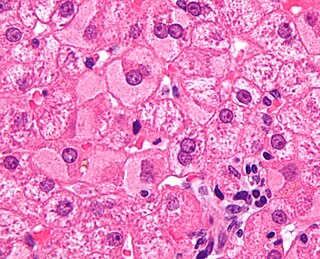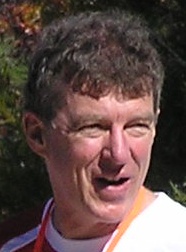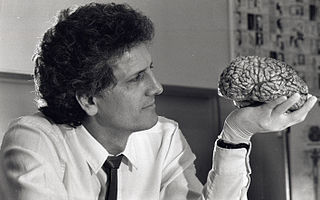
Hepatitis C is an infectious disease caused by the hepatitis C virus (HCV) that primarily affects the liver; it is a type of viral hepatitis. During the initial infection people often have mild or no symptoms. Occasionally a fever, dark urine, abdominal pain, and yellow tinged skin occurs. The virus persists in the liver in about 75% to 85% of those initially infected. Early on, chronic infection typically has no symptoms. Over many years however, it often leads to liver disease and occasionally cirrhosis. In some cases, those with cirrhosis will develop serious complications such as liver failure, liver cancer, or dilated blood vessels in the esophagus and stomach.
Needle sharing is the practice of intravenous drug-users by which a needle or syringe is shared by multiple individuals to administer intravenous drugs such as heroin, steroids, and hormones. This is a primary vector for blood-borne diseases which can be transmitted through blood. People who inject drugs (PWID) are at an increased risk for Hepatitis C (HCV) and HIV due to needle sharing practices. From 1933 to 1943, malaria was spread between users in the New York City area by this method. Afterwards, the use of quinine as a cutting agent in drug mixes became more common. Harm reduction efforts including safe disposal of needles, supervised injection sites, and public education may help bring awareness on safer needle sharing practices.

Hepatitis E is inflammation of the liver caused by infection with the hepatitis E virus (HEV); it is a type of viral hepatitis. Hepatitis E has mainly a fecal-oral transmission route that is similar to hepatitis A, although the viruses are unrelated. In retrospect, the earliest known epidemic of hepatitis E occurred in 1955 in New Delhi, but the virus was not isolated until 1983 by Russian scientists investigating an outbreak in Afghanistan. HEV is a positive-sense, single-stranded, nonenveloped, RNA icosahedral virus and one of five known human hepatitis viruses: A, B, C, D, and E.

Viral hepatitis is liver inflammation due to a viral infection. It may present in acute form as a recent infection with relatively rapid onset, or in chronic form.

Emtricitabine, with trade name Emtriva, is a nucleoside reverse-transcriptase inhibitor (NRTI) for the prevention and treatment of HIV infection in adults and children.

Tenofovir disoproxil, sold under the trade name Viread among others, is a medication used to treat chronic hepatitis B and to prevent and treat HIV/AIDS. It is generally recommended for use with other antiretrovirals. It may be used for prevention of HIV/AIDS among those at high risk before exposure, and after a needlestick injury or other potential exposure. It is sold both by itself and together in combinations such as emtricitabine/tenofovir, efavirenz/emtricitabine/tenofovir, and elvitegravir/cobicistat/emtricitabine/tenofovir. It does not cure HIV/AIDS or hepatitis B. It is available by mouth as a tablet or powder.

Ian Hector Frazer is a Scottish-born Australian immunologist, the founding CEO and Director of Research of the Translational Research Institute (Australia). Frazer and Jian Zhou developed and patented the basic technology behind the HPV vaccine against cervical cancer at the University of Queensland. Researchers at the National Cancer Institute, Georgetown University, and University of Rochester also contributed to the further development of the cervical cancer vaccine in parallel.
Human Immunodeficiency Virus (HIV) and Hepatitis C Virus (HCV) co-infection is a multi-faceted, chronic condition that significantly impacts public health. According to the World Health Organization (WHO), 2 to 15% of those infected with HIV are also affected by HCV, increasing their risk of morbidity and mortality due to accelerated liver disease. The burden of co-infection is especially high in certain high-risk groups, such as intravenous drug users and men who have sex with men. These individuals who are HIV-positive are commonly co-infected with HCV due to shared routes of transmission including, but not limited to, exposure to HIV-positive blood, sexual intercourse, and passage of the Hepatitis C virus from mother to infant during childbirth.

The history of HIV/AIDS in Australia is distinctive, as Australian government bodies recognised and responded to the AIDS pandemic relatively swiftly, with the implementation of effective disease prevention and public health programs, such as needle and syringe programs (NSPs). As a result, despite significant numbers of at-risk group members contracting the virus in the early period following its discovery, the country achieved and has maintained a low rate of HIV infection in comparison to the rest of the world.

Hepatitis B virus (HBV) is a partially double-stranded DNA virus, a species of the genus Orthohepadnavirus and a member of the Hepadnaviridae family of viruses. This virus causes the disease hepatitis B.

The Kirby Institute is a medical research organisation affiliated with the University of New South Wales and based on UNSW's Kensington campus. Founded in 1986, its initial research focus on HIV/AIDS has expanded over time to include viral hepatitis, sexually transmitted infections and a range of other infectious diseases.

Katharina Gaus was a German-Australian immunologist and molecular microscopist. She was an NHMRC Senior Research Fellow and founding head of the Cellular Membrane Biology Lab, part of the Centre for Vascular Research at the University of New South Wales. Gaus used new super-resolution fluorescence microscopes to examine the plasma membrane within intact living cells, and study cell signalling at the level of single molecules to better understand how cells "make decisions". A key discovery of Gaus and her team was how T-cells decide to switch on the body's immune system to attack diseases. Her work is of importance to the development of drugs that can work with T-cells in support of the immune system.
Michelle Haber is an Australian cancer researcher.

George Paxinos AO DSc FASSA FAA FRSN FAHMS is a Greek Australian neuroscientist, born in Ithaca, Greece. He completed his BA in psychology at the University of California at Berkeley and his PhD at McGill University in Montreal, Canada. After a postdoctoral year at Yale University, he moved to the School of Psychology of the University of New South Wales in Sydney, Australia. He is currently an NHMRC Senior Principal Research Fellow at Neuroscience Research Australia and Scientia Professor of Medical Sciences at the University of New South Wales.
David Albert Cooper was an Australian HIV/AIDS researcher, immunologist, professor at the University of New South Wales, and the director of the Kirby Institute. He and Professor Ron Penny diagnosed the first case of HIV in Australia.

Sharon Ruth Lewin, FRACP, FAHMS is the inaugural Director of the Peter Doherty Institute for Infection and Immunity. She is also a Professor of Medicine at The University of Melbourne and a National Health and Medical Research Council (NHMRC) Practitioner Fellow. As an infectious diseases physician and basic scientist, her laboratory focuses on basic, translational and clinical research aimed at finding a cure for HIV and understanding the interaction between HIV and hepatitis B virus. Her laboratory is funded by the NHMRC, the National Institutes of Health, The Wellcome Trust, the American Foundation for AIDS Research and multiple commercial partnerships. She is also the Chief Investigator of a NHMRC Centre of Research Excellence (CRE), The Australian Partnership for Preparedness Research on Infectious Diseases Emergencies (APPRISE) that aims to bring together Australia’s leading experts in clinical, laboratory and public health research to address the key components required for a rapid and effective emergency response to infectious diseases.
Professor David Wayne Johnson is an Australian nephrologist known for kidney treatments and transplants in Australia. In 2009 he was a Queensland State Finalist for Australian of the Year, for his work in the early recognition and care of people with chronic kidney disease and specifically for his work in detection of chronic kidney disease.
Alan Frederick Cowman AC, FRS, FAA, CorrFRSE, FAAHMS, FASP, FASM is an internationally acclaimed malaria researcher whose work specialises in researching the malaria-causing parasite, Plasmodium falciparum, and the molecular mechanisms it uses to evade host responses and antimalarial drugs. He is currently Deputy Directory of the Walter and Eliza Hall Institute of Medical Research (WEHI) in Melbourne, and his laboratory continues to work on understanding how Plasmodium falciparum, infects humans and causes disease. He was elected as a Fellow of the Royal Society in 2011 and awarded the Companion of the Order of Australia in 2019 for his "eminent service to the biological sciences, notably to molecular parasitology, to medical research and scientific education, and as a mentor."
Kaarin Anstey is an Australian Laureate Fellow and one of Australia's top dementia scientists. She is Co-Deputy Director of the ARC Centre of Excellence in Population Ageing Research (CEPAR) at the University of New South Wales, Australia, where she is Scientia Professor of Psychology. Kaarin Anstey is an Honorary Professor at the Australian National University and a Fellow of the Academy of the Social Sciences in Australia. She is a Director of the NHMRC Dementia Centre for Research Collaboration, Senior Principal Research Scientist at NeuRA and leads the NHMRC Centre of Research Excellence in Cognitive Health and the UNSW Ageing Futures Institute.
Glenda Margaret Halliday is an Australian neuroscientist. As of 2021, she is a professor at the University of Sydney and research fellow in the National Health and Medical Research Council (NHMRC). She was named 2022 NSW Scientist of the Year.











